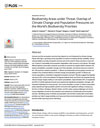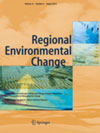-
Climate and Human Change in Biodiversity Hotspots, and Assessing the Tradeoffs of Bolivia’s Quinoa Craze
March 1, 2017 By Sara Merken In a recent article published in PLOS ONE, Juliann E. Aukema, Narcisa G. Pricope, Gregory J. Husak, and David Lopez-Carr address the impacts of climate change and population growth on areas with vulnerable ecosystem services and biodiversity, and in reverse, how degraded ecosystem services effect vulnerable populations. The authors analyze locations between 50 degrees latitude north and south that had changing precipitation patterns in the past 30 years.Through a multi-step process that used data about population, precipitation, and conservation during the wettest three months of the year, the authors find that areas with high population growth and a change in precipitation are “vulnerable to environmental degradation and food insecurity.” Additionally, climate change and precipitation variability can lead to ecosystem degradation and loss of ecosystem services, especially in places like Eastern Africa, the Himalayas, the Western Ghats, and Sri Lanka. The authors suggest that identifying areas that combine climate variability and population growth can help target conservation efforts that “promote biodiversity and ecosystem services while improving human well-being.”
In a recent article published in PLOS ONE, Juliann E. Aukema, Narcisa G. Pricope, Gregory J. Husak, and David Lopez-Carr address the impacts of climate change and population growth on areas with vulnerable ecosystem services and biodiversity, and in reverse, how degraded ecosystem services effect vulnerable populations. The authors analyze locations between 50 degrees latitude north and south that had changing precipitation patterns in the past 30 years.Through a multi-step process that used data about population, precipitation, and conservation during the wettest three months of the year, the authors find that areas with high population growth and a change in precipitation are “vulnerable to environmental degradation and food insecurity.” Additionally, climate change and precipitation variability can lead to ecosystem degradation and loss of ecosystem services, especially in places like Eastern Africa, the Himalayas, the Western Ghats, and Sri Lanka. The authors suggest that identifying areas that combine climate variability and population growth can help target conservation efforts that “promote biodiversity and ecosystem services while improving human well-being.”  Farming in Bolivia has recently transitioned from largely subsistence to quinoa mono-cropping, making it the world’s leading quinoa producer. In an article in Regional Environmental Change, Lorenzo Chelleri, Guido Minucci, and Eirini Skrimizea evaluate the link between social-ecological vulnerability and resilience by comparing the trade-offs within communities between adaptive capacity and increased income. The authors held 18 participatory workshops in southern Bolivia to gather feedback from farmers and conducted interviews with local policymakers and market regulators. The authors find that changes in land use, livestock, community behaviors, and institutional frameworks to accommodate the quinoa production have had “numerous trade-offs,” including reducing economic diversity and innovation, building community networks, creation of a quinoa black market, and increasing poverty and soil erosion. They recommend “a more open-ended understanding of both resilience and vulnerability,” but also caution that this is only a “snapshot of the transition” and cannot predict long-term changes.
Farming in Bolivia has recently transitioned from largely subsistence to quinoa mono-cropping, making it the world’s leading quinoa producer. In an article in Regional Environmental Change, Lorenzo Chelleri, Guido Minucci, and Eirini Skrimizea evaluate the link between social-ecological vulnerability and resilience by comparing the trade-offs within communities between adaptive capacity and increased income. The authors held 18 participatory workshops in southern Bolivia to gather feedback from farmers and conducted interviews with local policymakers and market regulators. The authors find that changes in land use, livestock, community behaviors, and institutional frameworks to accommodate the quinoa production have had “numerous trade-offs,” including reducing economic diversity and innovation, building community networks, creation of a quinoa black market, and increasing poverty and soil erosion. They recommend “a more open-ended understanding of both resilience and vulnerability,” but also caution that this is only a “snapshot of the transition” and cannot predict long-term changes. Sources: PLOS ONE, Regional Environmental Change.
 A Publication of the Stimson Center.
A Publication of the Stimson Center.





